Hanchen Li
Agentic Context Engineering: Evolving Contexts for Self-Improving Language Models
Oct 06, 2025Abstract:Large language model (LLM) applications such as agents and domain-specific reasoning increasingly rely on context adaptation -- modifying inputs with instructions, strategies, or evidence, rather than weight updates. Prior approaches improve usability but often suffer from brevity bias, which drops domain insights for concise summaries, and from context collapse, where iterative rewriting erodes details over time. Building on the adaptive memory introduced by Dynamic Cheatsheet, we introduce ACE (Agentic Context Engineering), a framework that treats contexts as evolving playbooks that accumulate, refine, and organize strategies through a modular process of generation, reflection, and curation. ACE prevents collapse with structured, incremental updates that preserve detailed knowledge and scale with long-context models. Across agent and domain-specific benchmarks, ACE optimizes contexts both offline (e.g., system prompts) and online (e.g., agent memory), consistently outperforming strong baselines: +10.6% on agents and +8.6% on finance, while significantly reducing adaptation latency and rollout cost. Notably, ACE could adapt effectively without labeled supervision and instead by leveraging natural execution feedback. On the AppWorld leaderboard, ACE matches the top-ranked production-level agent on the overall average and surpasses it on the harder test-challenge split, despite using a smaller open-source model. These results show that comprehensive, evolving contexts enable scalable, efficient, and self-improving LLM systems with low overhead.
HypoEval: Hypothesis-Guided Evaluation for Natural Language Generation
Apr 09, 2025Abstract:Large language models (LLMs) have demonstrated great potential for automating the evaluation of natural language generation. Previous frameworks of LLM-as-a-judge fall short in two ways: they either use zero-shot setting without consulting any human input, which leads to low alignment, or fine-tune LLMs on labeled data, which requires a non-trivial number of samples. Moreover, previous methods often provide little reasoning behind automated evaluations. In this paper, we propose HypoEval, Hypothesis-guided Evaluation framework, which first uses a small corpus of human evaluations to generate more detailed rubrics for human judgments and then incorporates a checklist-like approach to combine LLM's assigned scores on each decomposed dimension to acquire overall scores. With only 30 human evaluations, HypoEval achieves state-of-the-art performance in alignment with both human rankings (Spearman correlation) and human scores (Pearson correlation), on average outperforming G-Eval by 11.86% and fine-tuned Llama-3.1-8B-Instruct with at least 3 times more human evaluations by 11.95%. Furthermore, we conduct systematic studies to assess the robustness of HypoEval, highlighting its effectiveness as a reliable and interpretable automated evaluation framework.
CacheBlend: Fast Large Language Model Serving with Cached Knowledge Fusion
May 26, 2024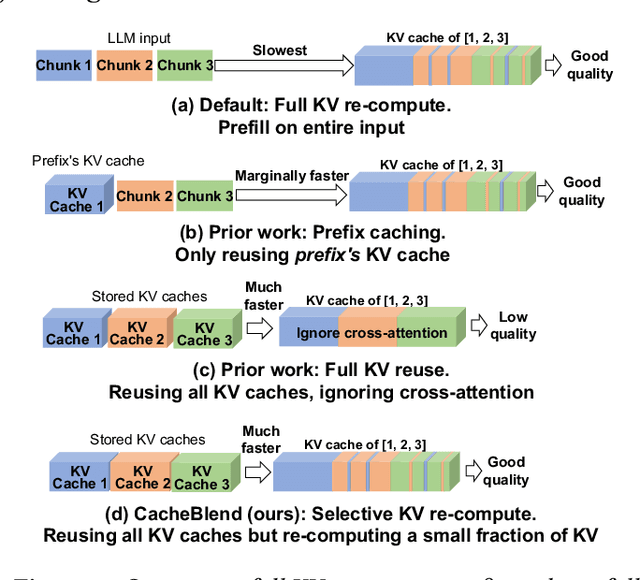
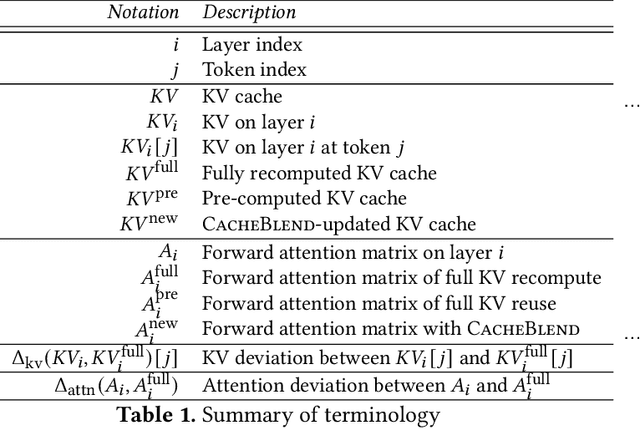
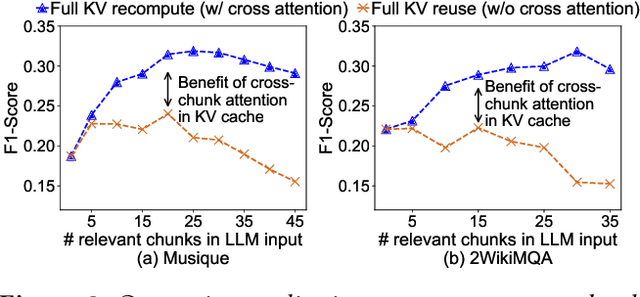
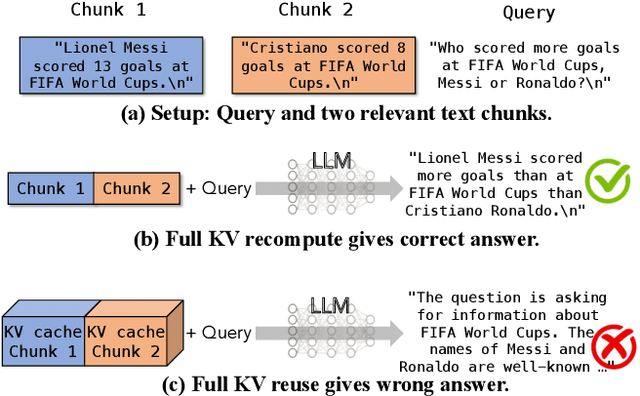
Abstract:Large language models (LLMs) often incorporate multiple text chunks in their inputs to provide the necessary contexts. To speed up the prefill of the long LLM inputs, one can pre-compute the KV cache of a text and re-use the KV cache when the context is reused as the prefix of another LLM input. However, the reused text chunks are not always the input prefix, and when they are not, their precomputed KV caches cannot be directly used since they ignore the text's cross-attention with the preceding text in the LLM input. Thus, the benefits of reusing KV caches remain largely unrealized. This paper tackles just one question: when an LLM input contains multiple text chunks, how to quickly combine their precomputed KV caches in order to achieve the same generation quality as the expensive full prefill (i.e., without reusing KV cache)? We present CacheBlend, a scheme that reuses the pre-computed KV caches, regardless prefix or not, and selectively recomputes the KV values of a small subset of tokens to partially update each reused KV cache. In the meantime,the small extra delay for recomputing some tokens can be pipelined with the retrieval of KV caches within the same job,allowing CacheBlend to store KV caches in slower devices with more storage capacity while retrieving them without increasing the inference delay. By comparing CacheBlend with the state-of-the-art KV cache reusing schemes on three open-source LLMs of various sizes and four popular benchmark datasets of different tasks, we show that CacheBlend reduces time-to-first-token (TTFT) by 2.2-3.3X and increases the inference throughput by 2.8-5X, compared with full KV recompute, without compromising generation quality or incurring more storage cost.
Chatterbox: Robust Transport for LLM Token Streaming under Unstable Network
Jan 23, 2024



Abstract:To render each generated token in real time, the LLM server generates response tokens one by one and streams each generated token (or group of a few tokens) through the network to the user right after it is generated, which we refer to as LLM token streaming. However, under unstable network conditions, the LLM token streaming experience could suffer greatly from stalls since one packet loss could block the rendering of tokens contained in subsequent packets even if they arrive on time. With a real-world measurement study, we show that current applications including ChatGPT, Claude, and Bard all suffer from increased stall under unstable network. For this emerging token streaming problem in LLM Chatbots, we propose a novel transport layer scheme, called Chatterbox, which puts new generated tokens as well as currently unacknowledged tokens in the next outgoing packet. This ensures that each packet contains some new tokens and can be independently rendered when received, thus avoiding aforementioned stalls caused by missing packets. Through simulation under various network conditions, we show Chatterbox reduces stall ratio (proportion of token rendering wait time) by 71.0% compared to the token streaming method commonly used by real chatbot applications and by 31.6% compared to a custom packet duplication scheme. By tailoring Chatterbox to fit the token-by-token generation of LLM, we enable the Chatbots to respond like an eloquent speaker for users to better enjoy pervasive AI.
CacheGen: Fast Context Loading for Language Model Applications
Oct 11, 2023



Abstract:As large language models (LLMs) take on more complex tasks, their inputs incorporate longer contexts to respond to questions that require domain knowledge or user-specific conversational histories. Yet, using long contexts poses a challenge for responsive LLM systems, as nothing can be generated until all the contexts are fetched to and processed by the LLM. Existing systems optimize only the computation delay in context processing (e.g., by caching intermediate key-value features of the text context) but often cause longer network delays in context fetching (e.g., key-value features consume orders of magnitude larger bandwidth than the text context). This paper presents CacheGen to minimize the delays in fetching and processing contexts for LLMs. CacheGen reduces the bandwidth needed for transmitting long contexts' key-value (KV) features through a novel encoder that compresses KV features into more compact bitstream representations. The encoder combines adaptive quantization with a tailored arithmetic coder, taking advantage of the KV features' distributional properties, such as locality across tokens. Furthermore, CacheGen minimizes the total delay in fetching and processing a context by using a controller that determines when to load the context as compressed KV features or raw text and picks the appropriate compression level if loaded as KV features. We test CacheGen on three models of various sizes and three datasets of different context lengths. Compared to recent methods that handle long contexts, CacheGen reduces bandwidth usage by 3.7-4.3x and the total delay in fetching and processing contexts by 2.7-3x while maintaining similar LLM performance on various tasks as loading the text contexts.
Grace++: Loss-Resilient Real-Time Video Communication under High Network Latency
May 21, 2023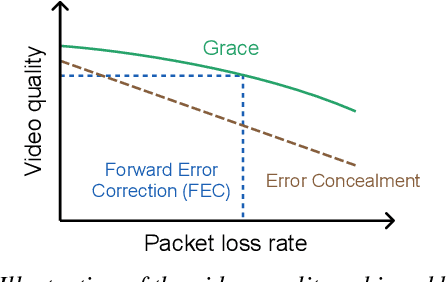
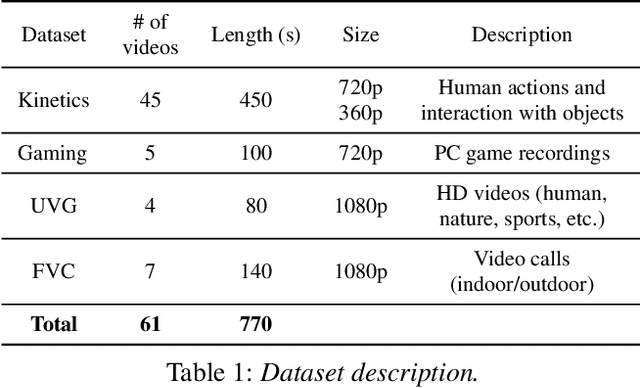
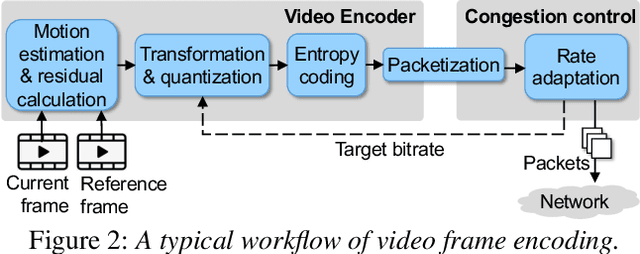

Abstract:In real-time videos, resending any packets, especially in networks with high latency, can lead to stuttering, poor video quality, and user frustration. Despite extensive research, current real-time video systems still use redundancy to handle packet loss, thus compromising on quality in the the absence of packet loss. Since predicting packet loss is challenging, these systems only enhance their resilience to packet loss after it occurs, leaving some frames insufficiently protected against burst packet losses. They may also add too much redundancy even after the packet loss has subsided. We present Grace++, a new real-time video communication system. With Grace++, (i) a video frame can be decoded, as long as any non-empty subset of its packets are received, and (ii) the quality gracefully degrades as more packets are lost, and (iii) approximates that of a standard codec (like H.265) in absence of packet loss. To achieve this, Grace++ encodes and decodes frames by using neural networks (NNs). It uses a new packetization scheme that makes packet loss appear to have the same effect as randomly masking (zeroing) a subset of elements in the NN-encoded output, and the NN encoder and decoder are specially trained to achieve decent quality if a random subset of elements in the NN-encoded output are masked. Using various test videos and real network traces, we show that the quality of Grace++ is slightly lower than H.265 when no packets are lost, but significantly reduces the 95th percentile of frame delay (between encoding a frame and its decoding) by 2x when packet loss occurs compared to other loss-resilient schemes while achieving comparable quality. This is because Grace++ does not require retransmission of packets (unless all packets are lost) or skipping of frames.
 Add to Chrome
Add to Chrome Add to Firefox
Add to Firefox Add to Edge
Add to Edge